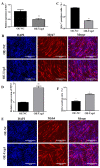Uncoupling Protein 3 Promotes the Myogenic Differentiation of Type IIb Myotubes in C2C12 Cells
- PMID: 38002992
- PMCID: PMC10671304
- DOI: 10.3390/genes14112049
Uncoupling Protein 3 Promotes the Myogenic Differentiation of Type IIb Myotubes in C2C12 Cells
Abstract
Uncoupling protein 3 (Ucp3) is an important transporter within mitochondria and is mainly expressed in skeletal muscle, brown adipose tissue and the myocardium. However, the effects of Ucp3 on myogenic differentiation are still unclear. This study evaluated the effects of Ucp3 on myogenic differentiation, myofiber type and energy metabolism in C2C12 cells. Gain- and loss-of-function studies revealed that Ucp3 could increase the number of myotubes and promote the myogenic differentiation of C2C12 cells. Furthermore, Ucp3 promoted the expression of the type IIb myofiber marker gene myosin heavy chain 4 (Myh4) and decreased the expression of the type I myofiber marker gene myosin heavy chain 7 (Myh7). In addition, energy metabolism related to the expression of PPARG coactivator 1 alpha (Pgc1-α), ATP synthase, H+ transportation, mitochondrial F1 complex, alpha subunit 1 (Atp5a1), lactate dehydrogenase A (Ldha) and lactate dehydrogenase B (Ldhb) increased with Ucp3 overexpression. Ucp3 could promote the myogenic differentiation of type IIb myotubes and accelerate energy metabolism in C2C12 cells. This study can provide the theoretical basis for understanding the role of Ucp3 in energy metabolism.
Keywords: C2C12 cells; Ucp3; energy metabolism; myogenic differentiation; types of myotubes.
Conflict of interest statement
The authors declare no conflict of interest.
Figures






Similar articles
-
Role of the α2 subunit of AMP-activated protein kinase and its nuclear localization in mitochondria and energy metabolism-related gene expressions in C2C12 cells.Metabolism. 2019 Jan;90:52-68. doi: 10.1016/j.metabol.2018.10.003. Epub 2018 Oct 23. Metabolism. 2019. PMID: 30359677
-
Capric Acid Up-Regulates UCP3 Expression without PDK4 Induction in Mouse C2C12 Myotubes.J Nutr Sci Vitaminol (Tokyo). 2016;62(1):32-9. doi: 10.3177/jnsv.62.32. J Nutr Sci Vitaminol (Tokyo). 2016. PMID: 27117849
-
Divergent effects of GLP-1 analogs exendin-4 and exendin-9 on the expression of myosin heavy chain isoforms in C2C12 myotubes.Peptides. 2011 Jun;32(6):1313-9. doi: 10.1016/j.peptides.2011.03.018. Epub 2011 Mar 29. Peptides. 2011. PMID: 21453734
-
Uncoupling Proteins in Striated Muscle Tissue: Known Facts and Open Questions.Antioxid Redox Signal. 2022 Aug;37(4-6):324-335. doi: 10.1089/ars.2021.0258. Epub 2022 Apr 18. Antioxid Redox Signal. 2022. PMID: 35044239 Review.
-
Mitochondrial uncoupling protein 3 and its role in cardiac- and skeletal muscle metabolism.Physiol Behav. 2008 May 23;94(2):259-69. doi: 10.1016/j.physbeh.2007.11.039. Epub 2007 Nov 28. Physiol Behav. 2008. PMID: 18191161 Review.
References
-
- Qaisar R., Renaud G., Hedstrom Y., Pöllänen E., Ronkainen P., Kaprio J., Alen M., Sipilä S., Artemenko K., Bergquist J., et al. Hormone replacement therapy improves contractile function and myonuclear organization of single muscle fibres from postmenopausal monozygotic female twin pairs. J. Physiol. 2013;591:2333–2344. doi: 10.1113/jphysiol.2012.250092. - DOI - PMC - PubMed
Publication types
MeSH terms
Substances
Grants and funding
LinkOut - more resources
Full Text Sources
Miscellaneous

